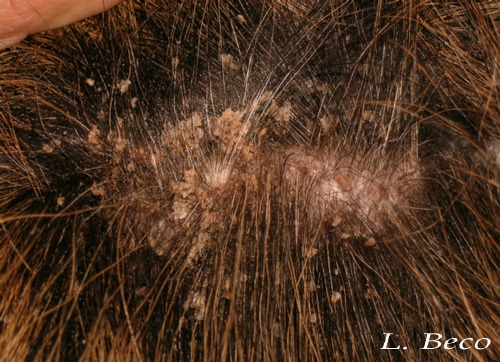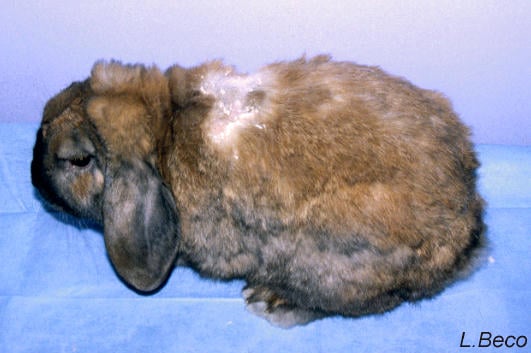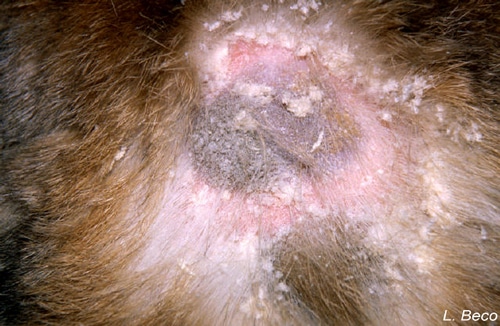Cheyletiellosis: A Comprehensive Guide to Fur Mite Infection in Pets
Introduction
Cheyletiellosis, also known as fur mite infestation, is a parasitic skin disease that occurs in various types of domestic animals such as dogs, cats, rabbits and horses. Cheyletellae are ectoparasites that belong to the class of arachnids and feed on skin flakes. In this article, we will take an in-depth look at the various aspects of cheyletiellosis, including its symptoms, diagnosis, treatment, and prevention.



(C) https://www.monvt.eu/pathologien/parasitaeren-hautmedizin/cheyletiella/
Cheyletiella mite life cycle
Cheyletiella mites go through several stages of development, starting with the egg, followed by a larva and two nymphal stages before growing into an adult mite. The life cycle of these mites lasts about six weeks and takes place exclusively on the host, as their viability in the environment is limited.
Transmission and risk of infection
Cheyletiella mites are transmitted through direct contact between animals. Since these mites are highly contagious, they can also be transmitted to humans (zoonosis).
Symptoms of cheyletiellosis
The symptoms of cheyletiellosis can vary depending on the severity of the infestation. Typical signs of infection are:
- Itching, especially in the back area and on the outer edges of the ears
- Flaking and dry skin
- Skin redness
- crust formation
However, if the infestation is small, the infection can have no symptoms and only lead to increased scaling.
Diagnosis of cheyletiellosis
The diagnosis of cheyletiellosis is usually made by detecting the mites. This can be done in different ways:
- Adhesive tape impression preparation : A strip of clear adhesive tape is pressed onto the affected areas of skin and then stuck to a microscope slide. The mites can usually be clearly seen under the microscope.
- Flea comb examination : A flea comb is used to comb the hair and catch the dandruff that falls out. The scales can then be examined under a microscope using tape and a microscope slide.
- Fecal examination : Since the animals often lick and nibble due to the intense itching, the mites can also be excreted in the feces. A fecal examination can therefore also detect Cheyletella infestation.
Treatment of cheyletiellosis
Treatment of cheyletiellosis should be carried out under veterinary guidance. There are various active ingredients available that can be administered as a shampoo, spot-on preparation, spray or in tablet form. Due to the long development cycle of Cheyletiella mites of six weeks, it is important to carry out treatment for at least this period. It is advisable to follow the instructions for the respective preparations exactly to ensure successful therapy.
Environmental treatment
Since Cheyletella can survive for up to 21 days without a host in the environment under favorable conditions, the animal's entire environment must be consistently cleaned and treated with contact insecticides. Items to be cleaned include pillows, blankets, baskets, brushes, etc., which should be washed with water of at least 55°C.
It is important to note that other pets such as cats, ferrets, rabbits and guinea pigs can also carry the mites without showing symptoms. Therefore, these animals should also be treated if they live in the same household.
Prognosis and prevention
If the affected animal and the other animals living in the household are treated for a sufficiently long period of time, as well as the surrounding area is treated carefully, the prognosis is good. In order to prevent a new infestation, good hygiene should be observed. This includes regular cleaning of the animal's environment as well as checking and treating all animals living in the household when necessary.
Cheyletiellosis in humans
As already mentioned, Cheyletella can be transmitted to humans. About every fifth contact person becomes infected. Small, itchy, red changes appear on the affected skin areas, which are often confused with mosquito bites or neurodermatitis. However, humans are so-called false hosts, which means that the mites cannot develop further on them and die. However, new skin changes continue to occur as long as the animal's mite infestation is not treated.
Frequently asked questions - FAQs:
How can you detect cheyletiellosis in pets?
A cheyletiellosis infestation in pets is usually manifested by severe itching, especially in the back area and on the edges of the ears. Affected animals often have very dry, heavily scaled skin, and sometimes crusts form. However, if the infestation is small, the disease can have no symptoms and is only accompanied by increased dandruff. An accurate diagnosis can be made by a veterinarian who can detect the mites under a microscope using tape swabs or flea combs.
How is Cheyletiellosis Treated in Pets?
The treatment of cheyletiellosis in pets involves the use of various active ingredients, which can be administered as shampoo, spot-on preparation, spray or in tablet form. Because of the long development cycle of Cheyletiella mites of six weeks, it is important to carry out treatment for at least this period. At the same time, the animal's environment must be consistently cleaned and treated with contact insecticides. Other animals in the household that may be carriers of the mites should also be treated.
Can people become infected with cheyletiellosis?
Yes, people can become infected with Cheyletiella mites. About one in five contacts with an infected animal show symptoms such as small, itchy, red changes on the skin. These skin changes can be confused with mosquito bites or neurodermatitis. However, humans are so-called false hosts, which means that the mites cannot develop further on them and die. However, the skin changes can recur until the animal's mite infestation has been successfully treated.
Summary
Cheyletiellosis is a parasitic skin disease caused by infestation by Cheyletiella mites. The disease affects various types of domestic animals and can also be transmitted to humans. Early diagnosis, consistent treatment of the affected animal as well as cleaning the environment and treating other animals living in the household are crucial for successful therapy. Good hygiene and attention to possible symptoms can minimize the risk of reinfestation.
If you have any further questions, please feel free to contact Dr. Krause or Ms. TÄ Perko .
